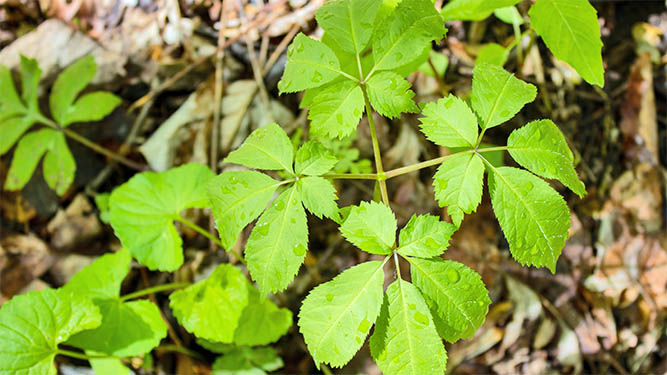Foraging has been around as long as humans and has become very popular recently as more people heading to fields and forests become aware of plant and fungi species as sources for food and medicine.
Some species foraged are common; non-native; fast growing and plentiful; produce many seeds quickly; and can be harvested without a negative impact to populations.
These common species include:
- Dandelion
- Violets
- Lambs quarters
- Common mullein
- Dozens of other common species
Most of the native woodland species harvested for medicinal or personal consumption are not as common; slow growing to maturity; need specialized habitat; produce few seeds; and may be protected by plant conservation regulations.
Vulnerable Species in Pennsylvania
American- Ginseng (Panax quinquefolius) is perhaps the most popular species that fit these criteria. Federal and state regulations exist to help protect naturally occurring populations of this species.
In Pennsylvania, American ginseng, Goldenseal, and Yellow Lady’s Slipper are listed as a Pennsylvania Vulnerable species in Title 17 Chapter 45, the Conservation of Pennsylvania Native Wild Plants.
These regulations also reflect federal regulations.
American Ginseng in Pennsylvania

Some things to know about ginseng:
- Grows in Pennsylvania under the forest canopy
- Some plants have been documented to be decades old
- Seeds are produced in red berries ripening this month
- Seeds require two winters to germinate
- Individual plants take 15 years to reach maximum seed production
- All parts of the plant can be used medicinally but traditionally the root is harvested and removes the reproductive capacity of a plant from the population
Harvesting American Ginseng
Regulations help to set good stewardship guidelines for harvesters. Stewardship is important to maintain existing natural populations in Pennsylvania.
The Department of Conservation and Natural Resources regulates the trade of ginseng and reports harvest information to the U.S. Fish and Wildlife Service.
These are the current regulations for harvesting American ginseng in Pennsylvania:
- Harvest season for ginseng is September 1 to November 30
- Harvesting on state land is prohibited in Pennsylvania
- Landowner permission is needed to harvest on private land
- A person may not have green ginseng in possession between April 1 and September 1
- The berries containing the seeds must be red at harvest and the seeds need to be replanted in the vicinity where the plants are harvested
- The plants need to have 3 leaves (aka prongs) of 5 leaflets each, which equates to a plant approximately 10 years of age
Protecting American Ginseng
Threats to American ginseng include:
- Illegal harvesting
- Deer browse
- Climate change
- Habitat alteration
- Invasive species
Illegal harvesting or poaching, out of season and on state owned land has reduced the American ginseng populations on state park and state forest lands.
Population monitoring on DCNR lands has indicated the disappearance of six known populations due to poaching.
Some foraging of common plants for personal consumption is allowed in state parks and state forests. Find the state forest guidelines (PDF) and state park harvesting guidelines (PDF) on the department’s website.
These permissions do not apply to species listed as endangered, threatened, rare or vulnerable including American ginseng.
Good stewardship practices include planting your own patch of American ginseng.
Seed is available through many Pennsylvania ginseng dealers. Buy stratified seed and plant now and into the fall. More detailed information about American ginseng (PDF) and growing American ginseng (PDF) is available from Penn State Extension.
Learning about the plants you forage for food or medicine can be fun and educational and at the same time help ensure that these populations will remain and grow in our forest ecosystems of Pennsylvania.